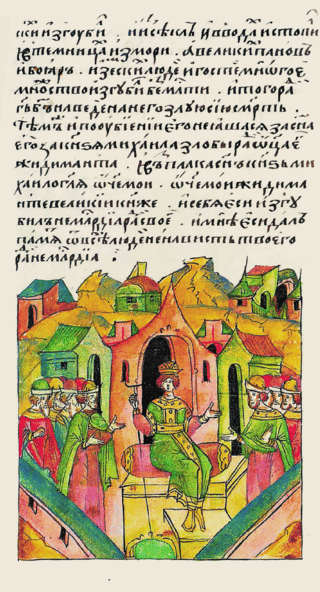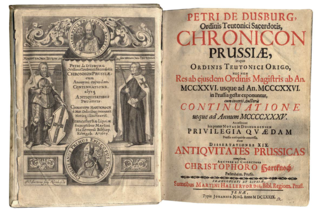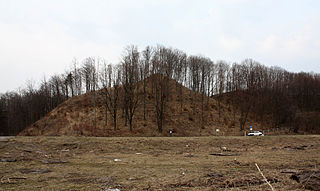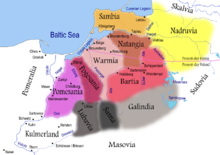
Dmitry the Older or Dmitry of Bryansk was the second eldest son of Algirdas, the Grand Duke of Lithuania, and his first wife Maria of Vitebsk. He was Duke of Bryansk from 1356 to 1379 and from 1388 to 1399.

Warmians were a Prussian tribe that lived in Warmia, a territory which now mostly forms part of the Warmian-Masurian Voivodeship in Poland, with a small northern portion located in neighbouring Russia. It was situated between the Vistula Lagoon, Łyna and Pasłęka Rivers.
Karijotas or Koriat was the Duke of Navahrudak and Vaŭkavysk, one of the sons of Gediminas, Grand Duke of Lithuania.

Michael Žygimantaitis was pretender to the throne of the Grand Duchy of Lithuania and the last male descendant of Kęstutis, Grand Duke of Lithuania.

Chronicon terræ Prussiæ is a chronicle of the Teutonic Knights, by Peter of Dusburg, finished in 1326. The manuscript is the first major chronicle of the Teutonic Order in Prussia and the Grand Duchy of Lithuania, completed some 100 years after the conquest of the crusaders into the Baltic region. It is a major source for information on the Order's battles with Old Prussians and Lithuanians.
The Palemonids were a legendary dynasty of Grand Dukes of the Grand Duchy of Lithuania. The legend was born in the 15th or 16th century as proof that Lithuanians and the Grand Duchy are of Roman origins. Already Jan Długosz (1415–1480) wrote that the Lithuanians were of Roman origin, but did not provide any proof. The legend is first recorded in the second edition of the Lithuanian Chronicle produced in the 1530s. At the time the Grand Duchy of Lithuania was quarrelling with the Kingdom of Poland, rejecting the claims that Poland had civilized the pagan and barbaric Lithuania. The Lithuanian nobility felt a need for the ruling dynasty to show upstanding origins, as the only available chronicles at the time were written by the Teutonic Knights, a long-standing enemy, and depicted Gediminas, ancestor of the Gediminids dynasty, as a hostler of Vytenis.

Pogesanians were a Prussian tribe, which lived in the region of Pogesania, a small territory stretched between the Elbląg and Pasłęka rivers, now located in the Warmian-Masurian Voivodeship, northern Poland. Pogesanians, as the rest of the Prussians, were conquered by the Teutonic Knights and became Germanized or Polonized. The old Prussian language became extinct sometime in the 17th century.

The Battle of Durbe was a medieval battle fought near Durbe, 23 km (14 mi) east of Liepāja, in present-day Latvia during the Livonian Crusade. On 13 July 1260, the Samogitians soundly defeated the joint forces of the Teutonic Knights from Prussia and Livonian Order from Livonia. Some 150 knights were killed, including Livonian Master Burchard von Hornhausen and Prussian Land Marshal Henrik Botel. It was by far the largest defeat of the knights in the 13th century: in the second-largest, the Battle of Aizkraukle, 71 knights were killed. The battle inspired the Great Prussian Uprising and the rebellions of the Semigallians, the Couronians, and the Oeselians. The battle undid two decades of Livonian conquests and it took some thirty years for the Livonian Order to restore its control.

The Treaty of Dovydiškės, Daudiske, or Daudisken was a secret treaty signed on 31 May 1380 between Jogaila, the Grand Duke of Lithuania, and Winrich von Kniprode, the Grand Master of the Teutonic Knights. The treaty was directed against Jogaila's uncle Kęstutis and its effect was to precipitate the Lithuanian Civil War (1381–1384).

The Prussian uprisings were two major and three smaller uprisings by the Old Prussians, one of the Baltic tribes, against the Teutonic Knights that took place in the 13th century during the Prussian Crusade. The crusading military order, supported by the Popes and Christian Europe, sought to conquer and convert the pagan Prussians. In the first ten years of the crusade, five of the seven major Prussian clans fell under the control of the less numerous Teutonic Knights. However, the Prussians rose against their conquerors on five occasions.
The Treaty of Christburg was a peace treaty signed on 2 February 1249 between the pagan Prussian clans, represented by a papal legate, and the Teutonic Knights. It is often cited as the end of the First Prussian Uprising, but it was not adhered to or enforced, especially after the Battle of Krücken in November 1249, where Prussians massacred and tortured to death 54 knights who had surrendered. The treaty guaranteed personal rights to all Prussians who converted to Christianity, but it did nothing to establish peace as many Prussians did not wish to convert and the Knights swore to root out paganism. It is one of the few documents from the period that survive in full to this day. It provides a useful insight into the life and religious tensions in pagan Prussia. It also offers a small glimpse into the Prussian mythology and traditions.

Diwanus was the leader (capitaneus) of the Bartians, one of the Prussian clans, during the Great Prussian Uprising (1260–1274) against the Teutonic Knights. He was son of Kleckis and therefore is sometimes referred to by a nickname derived from the word bear.

Battle of Pagastin was a medieval battle fought between the Teutonic Knights and Prussians in 1271 during the Great Prussian Uprising (1260–1274). Pagan Prussians rose against their conquerors, who tried to convert them to Christianity, after Lithuanians and Samogitians defeated the joint forces of the Teutonic Knights and the Livonian Order in the Battle of Durbe in 1260. The first years of the uprising were successful for the Prussians, but the Knights received reinforcements from Western Europe and were gaining the upper-hand in the conflict.

The Prussian Crusade was a series of 13th-century campaigns of Roman Catholic crusaders, primarily led by the Teutonic Knights, to Christianize under duress the pagan Old Prussians. Invited after earlier unsuccessful expeditions against the Prussians by Christian Polish kings, the Teutonic Knights began campaigning against the Prussians, Lithuanians and Samogitians in 1230. By the end of the century, having quelled several Prussian uprisings, the Knights had established control over Prussia and administered the conquered Prussians through their monastic state, eventually erasing the Prussian language, culture and pre-Christian religion by a combination of physical and ideological force. Some Prussians took refuge in neighboring Lithuania.

Andrei of Polotsk was the eldest son of Algirdas, Grand Duke of Lithuania, and his first wife Maria of Vitebsk. He was the Prince of Pskov and Polotsk (1342–1387). As the eldest son of the Grand Duke, Andrei claimed his right to the throne after his father's death in 1377. Algirdas left Jogaila, his eldest son with his second wife Uliana of Tver, as the rightful heir. Andrei's rivalry with Jogaila, Grand Duke of Lithuania and later King of Poland, eventually led to his demise.

Vygantas was Duke of Kernavė. He was one of the sons of Algirdas, Grand Duke of Lithuania (1345–1377), and his second wife Uliana Alexandrovna of Tver.
The Treaty of Dubysa or Treaty of Dubissa consisted of three legal acts formulated on 31 October 1382 between Jogaila, Grand Duke of Lithuania, with his brother Skirgaila and Konrad von Wallenrode, Marshal of the Teutonic Order. During the Lithuanian Civil War (1381–84), Teutonic Order helped Jogaila and Skirgaila to defeat their uncle Kęstutis and his son Vytautas. Trying to realize promises given by Jogaila during the war, Teutonic Order organized the negotiations for the treaty. The acts were signed after six days of negotiations on an island in the mouth of the Dubysa River. The treaty was never ratified and never came into effect. The civil war resumed in summer 1383.
The Raid on Brandenburg was a Polish–Lithuanian raid on the Margraviate of Brandenburg in February–March 1326. With papal approval and encouragement, King Władysław I of Poland allied with Gediminas of Lithuania and organized the raid against Louis V of Germany. Pope John XXII opposed Louis' ambitions to become the Holy Roman Emperor, King Władysław regarded Neumark as Polish territory, while Lithuanians sought loot. The Teutonic Knights, under papal pressure, observed its peace treaties with Poland and Lithuania and did not interfere. The Polish–Lithuanian army raided Brandenburg for a month, reaching Frankfurt and Berlin, and took 6,000 prisoners.
Józef Bielak was a Lithuanian Tatar general, who fought in the Bar Confederation, the War of 1792 and Uprising of 1794. He commanded the 4th Lithuanian Advance Guard Regiment from 1763 to his death in 1794.

Bisenė or Bisena was a wooden fortress of the Grand Duchy of Lithuania during the Lithuanian Crusade. It was one of the Lithuanian defensive outposts along the Neman River and was burned down by the Teutonic Order in 1283 and 1316. Its location was long debated and often confused with Pieštvė, but after 1985 research of Romas Batūra it has been generally accepted to be Kartupėnai Hill Fort near the confluence of the Kartupis and Neman in Jurbarkas District Municipality, Lithuania. After the burning down of Kolainiai in 1291 and Bisenė in 1316, Junigeda (Veliuona) became the westernmost Lithuanian fortress along the Neman.










